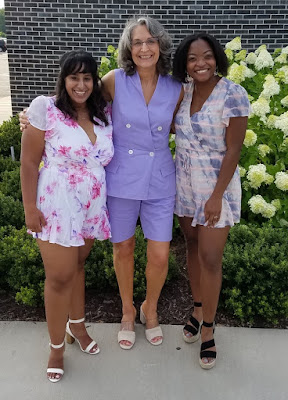Anyone else lose their sewing motivation during this Covid-19 quarantining, self isolation, social distancing, etc.?
An email with this message revived my sewing interest.
Design Challenge: Hoodies Anyone?
“Our first challenge is to invite our users to make a garment using the Hood as found in Garment Designer.”
I have owned Garment Designer (GD) pattern drafting software for about 6 years. I attended a fabulous GD workshop in New Mexico a couple years, but have not used it much since. I had to search for the software CD and security hasp to load it on my current laptop.
Software Website: Cochenille
Youtube:CochenilleSoftware
Hoods have never been on my radar. I am not a fan because when worn up, they block my peripheral vision. Give me a hat anytime. But that said, it was interesting to learn about hoods. How they are considered to be a "collar". And how to measure yourself and draft a hood based on your head width and height, as explained very clearly in these YouTube videos from Diane Denzel
Hood Pattern with Modifications
I was actually surprised at the wide variety of hood shapes. From basic (looks like a monk's hood) to the close fitting, multi seamed shapes of performance outerwear, and the unique but bazaar hoods of designer Issey Miyake. Part of my reason for reviewing hood drafting methods was to compare them to the hood options in GD so I understood the drafting rules, ease etc. used by the software.
Though I found some fabulous, hooded garment as inspirations, I had to choose one that was draftable based on my GD skills, and sewable by the Challenge due date. Here is the photo of the inspiration garment.
 |
| Hoodie inspiration photo |
It is a slightly flared, long cardigan, with a wide center band that starts at the hem and extends up the front and becomes the front section of the hood. When the hood is down, the band is like a big lapel that goes over the shoulder. The back, front and sleeves were easy to draft in GD, but I did have to manipulate the default hood pattern shape to factor in the band, and add the band piece itself using the Shape feature. I have included a picture of the GD pattern which includes information that other users can use to draft their own version. I know I really appreciate finding GD tips and patterns on the internet.
 |
| Garment Designer Hoodie Pattern |
The wide front band of this cardigan is a wonderful place for embellishment or color blocking.
 |
| Embellishment |
I chose to embellish it with appliques made from the same fabric, but with the wrong side (fuzzy) up to create tonal, textural contrast. I cut circles and donut shapes and applied fusible web to the back/ smooth side of the shapes. These were ironed to the front band.
The fabric I used is “Sage Mock-Bamboo 10 Ounce Sweatshirt Fleece Knit” of .95 rayon .5 spandex from Nick of Time Fabric This fabric was wonderfully thick, soft and drapey. I like to sew knit garments, made from “new to me” patterns, on the sewing machine to test the fit before serging. This fabric was not fun to sew on the sewing machine. It did not feed well because of the thickness and stretchiness. It was a dream to sew on the serger.
Yesterday it was so dark and rainy, the light sensor on the outside Christmas lights turned them on at 2 PM, thinking it was dusk. Depressing. But today it is crisp and clear and perfect for a few outdoor pictures.
 |
| Hoodie - drafted in Garment Designer software |
 |
| Hoodie |
















































